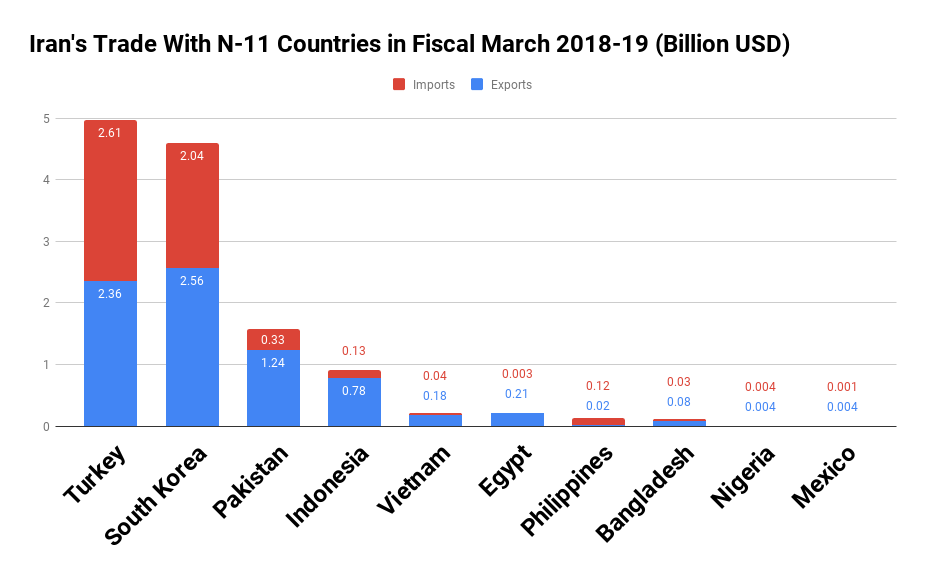Latest data released by the Islamic Republic of Iran Customs Administration show Iran’s exports totaled 18.69 million tons worth $7.49 billion during the year, indicating a 40.01% and 30.2% fall in tonnage and value respectively year-on-year.
Imports stood at 2.75 million tons worth $5.34 billion, down 38.25% and 33.27% in tonnage and value respectively YOY.
As such, Iran recorded $2.15 billion in non-oil trade surplus with the Next Eleven countries, Financial Tribune reported.
The Next Eleven are the 11 countries—Iran, Egypt, Indonesia, Bangladesh, Mexico, Nigeria, Pakistan, the Philippines, Turkey, South Korea and Vietnam—identified by Jim O'Neill, a British economist, in a research paper as having a high potential of becoming, along with the BRICS countries, the world's largest economies in the 21st century.
The bank chose these states, all with promising outlooks for investment and future growth, on Dec. 12, 2005. The criteria used were macroeconomic stability, political maturity, openness of trade and investment policies, and the quality of education.
The N-11 paper is a follow-up to the bank's 2003 paper on the four emerging "BRIC" economies.
Terence James O'Neill (born 17 March 1957) is best known for coining BRIC, the acronym that stands for Brazil, Russia, India and China—the four rapidly developing countries that have come to symbolize the shift in global economic power away from the developed N-11 economies.
Main Commodities, Trading Partners
Iran mainly exported gas condensates, liquefied natural gas, non-alloy semi-finished iron/steel products, bitumen, non-alloy iron and steel ingots, non-alloy zinc and liquefied propane to N-11 countries.
In exchange, major commodities imported into Iran from N-11 countries included cooking bananas, auto parts, semi- and wholly-milled rice, tobacco, vehicles, synthetic fibers and polyurethane.
In terms of total trade value, Turkey topped the list among N-11 countries with Iran trade standing at 8.15 million tons worth $4.98 billion, down by 49.54% and 30.61% in tonnage and value respectively YOY.
Exports to Turkey amounted to 6.76 million tons worth $2.36 billion to register a 52.72% and 40.22% decline in tonnage and value respectively YOY.
Turkey was Iran’s second biggest export destination among the countries under review and sixth in the whole world.

In return, Turkey exported 1.39 million tons of commodities worth $2.61 billion to Iran, down by 24.96% and 18.79% in tonnage and value respectively YOY.
Turkey was the top exporter of goods to Iran among N-11 and third in the world.
Major Iranian commodities exported to Turkey were liquefied natural gas, non-alloy zinc, aluminum, urea and bitumen.
For its part, Turkey mainly exported cooking bananas, tobacco and fiber to Iran.
South Korea was Iran’s second biggest trading partner among N-11 countries during the 12 months, as two-way commercial exchanges stood at 5.64 million tons worth $4.61 billion to register a 51.05% and 43.03% decline in tonnage and value respectively YOY.
Iran exported 4.91 million tons of goods worth $2.56 billion to South Korea, down by 51.07% and 41.46% in tonnage and value respectively YOY.
South Korea was Iran’s top export destination among N-11 countries and fifth in the world during the period.
Iran’s exports to South Korea included gas condensates, copper concentrates, chemicals and molybdenum oxide and hydroxide. It imported 735,116 tons of commodities worth $2.04 billion from South Korea, down 50.89% and 44.89% in tonnage and value respectively YOY, which mainly constituted auto parts, vehicles, chemicals and fridge parts.
South Korea was the second exporter of goods to Iran among N-11 states and seventh exporter to Iran in the world.
Pakistan was Iran’s third major trading partner among N-11 countries.
Trade between Iran and Pakistan amounted to 3.1 million tons worth $1.57 billion, indicating a 23.19% and 20.23% increase in tonnage and value respectively YOY.
Iran’s exports reached 2.8 million tons worth $1.24 billion, up 30.1% and 35.77% in tonnage and value respectively YOY, while Pakistan’s exports to Iran were at 298,439 tons worth $330.23 million, down by 17.83% and 16.06% in tonnage and value respectively YOY.
Pakistan was Iran’s third export destination as well as the third exporter of goods to Iran among N-11 countries. The country was Iran’s eighth export destination and 22nd exporter to Iran in the world.
Bitumen, hydrocarbon gases, low-density oils, liquefied propane, pod vegetables and pistachios were Iran’s main goods exported to Pakistan, while Pakistan mainly exported rice, sesame, boxes, pears and cows to Iran.
Highest Growths, Declines in Trade
Trade with Pakistan ($1.57 billion) and Indonesia ($917.86 million) witnessed the highest rises of 20.23% and 0.52% respectively YOY while trade with Mexico ($5.86 million), Nigeria ($8.97 million) and the Philippines ($147.65 million) saw the lowest declines of 83.84%, 55.41% and 54.03% respectively.
Iran’s exports to Pakistan ($1.24 billion), Indonesia ($786.86 million) and Bangladesh ($86.33 million) saw the highest growths of 35.77%, 21.27% and 2.24% respectively YOY while exports to Mexico ($4.72 million), Nigeria ($4.79 million) and the Philippines ($20.85 million) witnessed the lowest declines of 86.35%, 72.12% and 65.97% respectively.
Imports from Nigeria ($4.18 million) saw a growth of 42.14% YOY while imports from Egypt ($3.06 million), the Philippines ($126.79 million) and Indonesia ($131 million) witnessed the highest declines of 54.92%, 51.21% and 50.43% respectively YOY.


